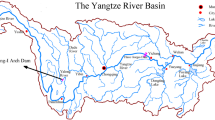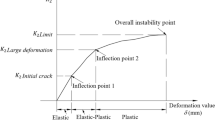Abstract
This paper focuses on the stability of arch dam abutment with interlayer shear zones, presents the experimental analysis on Lizhou Arch Dam, and implements comprehensive method by combining geo-mechanical model test with the finite element method to analyze the impact of interlayer shear zones on the stability of dam abutment. Firstly, 3D geo-mechanical model test is conducted and the model shows the impact of interlayer shear zones on stability of arch dam. According to the deformation behaviors and eventual failure form of rock mass and structure planes in dam abutment and dam foundation, the impact of interlayer shear zones unstable failure on the safety coefficient of arch dam is analyzed. Secondly, the FEM (Finite Element Method) is used for supplementary verification. As a conclusion of the analysis: Interlayer shear zones fj1 - fj4 are developing towards riverbed in the rock mass of the dam abutment of Lizhou Arch Dam, cutting through the rock mass of dam abutment and forming a bottom slide face. In the dam abutment, fault f5 and fracture Lp285 have developed and formed a side fracture plane by intersecting the interlayer shear zone. Under the effect of the resultant force of the arch abutment, with the interlayer shear zone of inferior properties as the bottom slide face, the rock mass of dam abutment slides out in the form of steps or drawers, and the stability of the dam and the foundation is influenced.
Similar content being viewed by others
References
Bruneau, G., Tyler, D. B., Hadjigeorgiou, J., and Potvin, Y. (2003). “Influence of faulting on a mine shaft-a case study: Part I-Background and instrumentation.” International Journal of Rock Mechanics and Mining Sciences, 2003, Vol. 40, No. 1, pp. 95–111.
Chen, J. Y., Zhang, L., Chen, Y., Dong, J. H., and Hu, C. Q. (2007). “Failure model test on deep anti-sliding stability of WUDU RCC gravity dam.” Chinese Journal of Rock Mechanics and Engineering, Vol. 26, No. 10, pp. 2097–2013, DOI: 10.3321/j.issn:1000-6915. 2007.10.020.
Chen, Y., Zhang, L., Chen, J. Y., Li, C. G., and Hu, C. Q. (2011). “Cracking similarity simulation of induced joints and its application in model test of a RCC arch dam.” KSCE Journal of Civil Engineering, Vol. 15, No. 2, pp. 327–335, DOI: 10.1007/s12205-011-0969-3.
Dong, J. H., Xie, H. P., Zhang, L., Chen, J. Y., and Hu, C. Q. (2007). “Experimental study of 3D geo-mechanical model on global stability of daganshan double curvature arch dam.” Chinese Journal of Rock Mechanics and Engineering, 2007, Vol. 26, No. 10, pp. 2027–2033, DOI: 10.3321/j.issn:1000-6915.2007.10.010.
Fei, W. P., Zhang, L., and Zhang, R. (2010). “Experimental study on a geo-mechanical model of a high arch dam.” International Journal of Rock Mechanics and Mining Sciences, Vol. 47, No. 2, pp. 299–306, DOI: 10.1016/j.ijrmms.2009.12.005.
Jiang, X. L., Cao, J. R., and Sun, S. W. (2002). “Geo-mechanical model test on entire stability for Goupitan hyperbolic arch dam.” Journal of Yangtze River Scientific Research Institute, 2002, Vol. 19, No. 6, pp. 21–24 (in Chinese)), DOI: 10.3969/j.issn.1001-5485.2002.06.006.
Li, K. G., Xu, J., and Li, S. C. (2005). “Study on property of rock mass discontinuity shear Strength in the Three Gorges reservoir area.” Rock and Soil Mechanics, 2005, Vol. 26, No. 7, pp. 1063–1067 (in Chinese), DOI: 10.3969/j.issn.1000-7598.2005.07.012.
Li, S. D., Li, X., Zhang, N. X., and Liu, Y. H. (2006). “Water-rock interaction of clay gouged intercalation sledging process of baota landslides in Three Gorges reservoir area.” Rock and Soil Mechanics, 2006, Vol. 27, No. 10, pp. 1841–1846, DOI: 10.3969/j.issn.1000-7598.2006.10.041.
Okubo, C. H. (2004). “Rock mass strength and slope stability of the Hilina slump, KIlauea volcano, Hawaii.” Journal of Volcanology and Geothermal Research, Vol. 138, Nos. 1-2, pp. 43–76, DOI: 10.1016/j.jvolgeores.2004.06.006.
Ren, G., M., Nie, D. X., and Mi, D. C. (1999). “A simulation study of physico-mechanical properties of intercalated gouge in layered weak zones.” Journal of Engineering Geology, 1999, Vol. 7, No. 1, pp. 65–71 (in Chinese)), DOI: 10.3969/j.issn.1004-9665.1999.01.012.
Xu, B. T., Qian, Q. H., and Yan, C. H. (2009). “Stability and strengthening analyses of slope rock mass containing multi-weak interlayers.” Chinese Journal of Rock Mechanics and Engineering, Vol. 28, Supp. 2, pp. 3959–3964 (in Chinese), DOI: 10.3321/j.issn:1000-6915.2009.z2.097.
Xu, D. P., Feng, X. T., Cui, Y. J., Jiang, Q., and Zhou, H. (2012). “On failure mode and shear behavior of rock mass with interlayer staggered zone.” Rock and Soil Mechanics, 2012, Vol. 33, No. 1, pp. 129–136 (in Chinese).
Yang, G. X., Zhang, L., Zhu, H. H., Chen, Y., and Hu, C. Q. (2012). “Application of fiber bragg grating sensor in geo-mechanical model test of arch dam.” Journal of Yangtze River Scientific Research Institute, Vol. 29, No. 8, pp. 52–57, DOI: 10.3969/j.issn.1001-5485.2012.08.010.
Zhang, D. L., Wang, Y. H., and Qu, T. Z. (2000). “Influence analysis of inter-band on stability of stratified rock mass.” Chinese Journal of Rock Mechanics and Engineering, Vol. 19, No. 2, pp. 140–144 (in Chinese), DOI: 10.3321/j.issn:1000-6915.2000.02.003.
Zhang, Z. L., Xu, W. Y., Zhao, H. B., and Jjian, B. (2010). “Investigation on shear creep experiments of sandstone with weak plane in Xiangjiaba Hydropower Station.” Chinese Journal of Rock Mechanics and Engineering, 2010, Vol. 29, No. S2, pp. 3693-3699 (in Chinese).
Zhou, W. Y., Yang, R. Q., Liu, Y. R., and Lin, P. (2005). “Research on geomechanical model of rupture tests of arch dams for their stability.” Journal of Hydroelectric Engineering, 2005, Vol. 24, No. 1, pp. 53–58, 64, DOI: 10.3969/j.issn.1003-1243.2005.01.008.
Author information
Authors and Affiliations
Corresponding author
Rights and permissions
About this article
Cite this article
Zelin, D., Qianqian, W. & Jing, W. Analysis on stability of an Arch Dam with interlayer shear zones. KSCE J Civ Eng 20, 2262–2269 (2016). https://doi.org/10.1007/s12205-015-0017-9
Received:
Revised:
Accepted:
Published:
Issue Date:
DOI: https://doi.org/10.1007/s12205-015-0017-9




